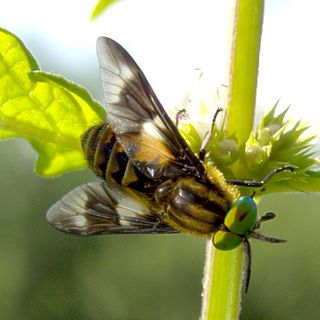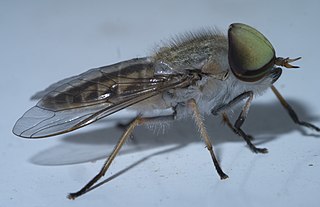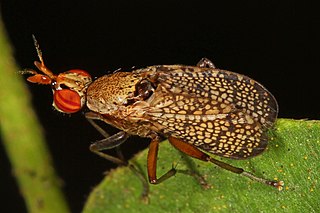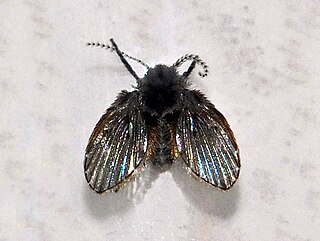
Psychodidae, called drain flies, sink flies, filter flies, sewer flies, or sewer gnats, is a family of true flies. Some genera have short, hairy bodies and wings giving them a "furry" moth-like appearance, hence one of their common names, moth flies. Members of the sub-family Phlebotominae which are hematophagous may be called sand flies in some countries, although this term is also used for other unrelated flies.

Superfamily Tabanoidea are insects in the order Diptera.

The Psychodinae are the nominate subfamily of moth flies (Psychodidae), also known as drain flies. Like most of their relatives, they are usually found in damp habitats; some occur in caves. The small larvae are aquatic or semi-terrestrial; the adults are winged and capable of flight. Psychodinae are found worldwide, including some subantarctic islands.

The Helcomyzidae are a small family of flies in the Acalyptratae. The larvae feed on kelp and other organic matter washed up on shorelines. Species diversity is highest in New Zealand and south temperate South America. They are sometimes allied with the families Dryomyzidae or Coelopidae.
Alloeodidicrum is a genus of drain flies in the subfamily Psychodinae. It consists of two species.

Tabaninae is a subfamily of horse flies in the family Tabanidae. There are more than 3000 described species in Tabaninae.

Tetanocerini is a tribe of flies in the family Sciomyzidae. There are more than 400 described species in the tribe.

Clogmia is a genus of drain flies in the subfamily Psychodinae.
Sycorax is a genus of moth flies and sand flies in the family Psychodidae. There are at least 40 described species in Sycorax.
Feuerborniella is a genus of flies belonging to the family Psychodidae.
Telmatoscopus is a genus of flies belonging to the family Psychodidae.

Philosepedon is a genus of flies belonging to the family Psychodidae.
Panimerus is a genus of flies belonging to the family Psychodidae.
Ulomyia is a genus of flies belonging to the family Psychodidae.

Pangoniinae is a subfamily of Horse-flies in the order Diptera, containing at least four tribes and 24 genera.
Didicrum is a genus of the family Psychodidae and has a handful of species studied so far. The discovery of this genus in Colombia represents a significant range extension for Didicrum as all previously described species of this genus are distributed in the Australasian region and the southernmost portion of South America.
Copidapha is a genus of flies in the family Tabanidae.








